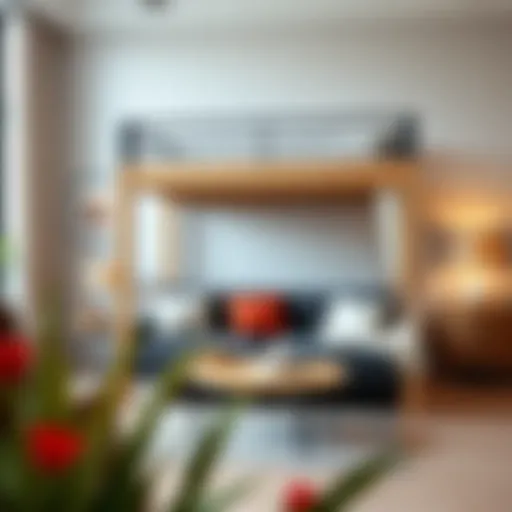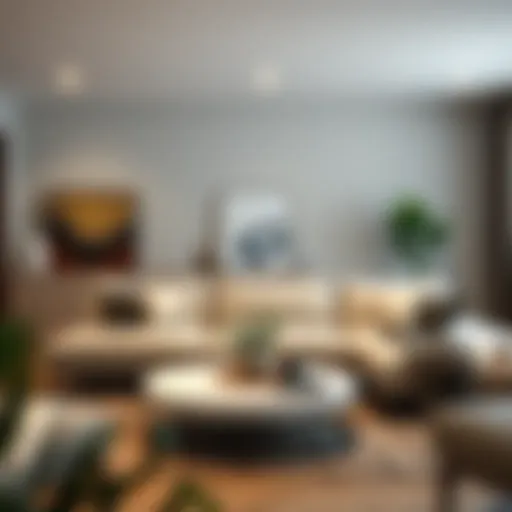Mastering the Art of Simple Bedroom Design


Intro
Creating a bedroom that radiates simplicity, clarity, and comfort is not just about throwing furniture into a space. It’s an art that requires thought and intention. Simplicity in bedroom design is often misinterpreted as a lack of personality or a cold, impersonal atmosphere. On the contrary, a thoughtful approach emphasizes individuality while ensuring all elements serve a purpose.
In an age where our lives can feel overwhelmingly hectic, the bedroom should stand as an oasis—a space that promotes relaxation and rejuvenation. Understanding the principles of simple bedroom interior design can guide homeowners and designers alike in crafting environments that are both functional and aesthetically pleasing. From the selection of colors to the choice of materials, this article will take a close look at the nuances involved in developing a serene and cozy bedroom.
Design choices often serve a dual purpose; they should be appealing to the eye while also fostering a peaceful ambiance. By focusing on simplicity, we strip away the excess—leaving behind only what truly matters, reflecting often the character and preferences of the individual.
Whether you're someone who enjoys a minimalist aesthetic or you simply want a space that isn’t overwhelmed by clutter, this guide aims to provide a comprehensive understanding of how simplicity can turn your bedroom into a personal sanctuary.
Understanding Simple Bedroom Design Principles
Understanding the principles of simple bedroom design helps create spaces that do not just look attractive but serve as a sanctuary for relaxation. Simplicity in design can elevate the overall harmony of a bedroom, making it a functional and inviting environment. This approach emphasizes clarity, organization, and a profound appreciation for what is essential in a living space. When considering bedroom design, it's crucial to reflect on how each element interacts with others to forge a cohesive aesthetic that resonates with personal style.
Defining Simplicity in Design
To grasp simplicity in design, one must first appreciate that it’s more than just a lack of clutter or decoration—it's an art of creating elegance through minimalism. Simplicity can be seen as a harmonious blend of form and function, showcasing how design can be streamlined without sacrificing personality. For example, opting for a sleek, unadorned headboard paired with soft linens can bring a serene balance that enhances comfort while still making a statement. By focusing on clean lines, neutral tones, and functional layouts, simplicity allows for individual flair without overwhelming the senses.
The Balance of Functionality and Aesthetics
A simple bedroom must showcase a fine balance between functionality and aesthetics. This balance ensures that while an area looks good, it is also practical for day-to-day life. Consider furniture selection—pieces that are stylish yet serve multiple purposes, like a bed with storage drawers or a bench that doubles as a seat and a storage unit, exemplify this harmony well. A place has to be more than a pretty sight—considerations such as ease of movement or proximity to common necessities play a pivotal role in creating a space that feels right. In essence, the best interiors do not just please the eyes; they cater to the needs, blending ease and style in deft synergy.
Creating a Cohesive Space
A cohesive space is fundamental in achieving the essence of simple bedroom design. Cohesion reflects the personality of the occupants while ensuring each component contributes effectively to the whole. One effective approach is to choose a color palette that resonates throughout the room, fusing elements together and eliminating visual discord. Natural materials—from linen to wood—can enhance this cohesion further by instilling a touch of continuity. It’s also beneficial to select decor that not only represents personal style but also aligns well with the overall theme.
In crafting a cohesive environment, consider these pointers:
- Color Consistency: Choose a limited palette that evokes tranquility.
- Material Harmonization: Use similar textures to elevate the aesthetic.
- Theme Integration: Adhere to a particular style or theme. This could range from minimalist Scandinavian to a snug bohemian touch.
"Creating a cohesive space is akin to composing a silent symphony, where every piece plays its part, resonating harmoniously with overall design."
The focus on simplicity allows for a serene atmosphere, providing an escape from the bustling outer world. When all aspects—color, function, and cohesion—come together, they result in a bedroom that is not only striking but also a genuine reflection of oneself.
Choosing a Color Palette
Selecting the right color palette is crucial in simple bedroom interior design. Colors can dramatically influence the mood and ambiance, setting the tone for relaxation and comfort. It’s not just about picking one or two shades; it’s about understanding how colors interact with each other and the environment around them.
When you choose your colors, consider how they reflect your style and personality while also promoting a serene space. Harmonious color choices can encourage a sense of balance and simplicity, reinforcing the room's purpose—a place to rest and recharge.
Neutral Shades for Tranquility
Neutral shades can be the backbone of simple bedroom design. Think of soft whites, muted beiges, and gentle greys. These colors help create a calming atmosphere—perfect for winding down after a long day. By opting for a neutral base, you can effortlessly adapt your accents and decorations over time without drastic changes.
Often, you'll find that a light grey can complement wooden tones nicely, giving that warm feel without overwhelming the senses. Imagine waking up in a serene environment where walls reflect the soft morning light, casting a tranquil glow that encourages relaxation. The key is to avoid stark contrasts—think soft transitions rather than sharp boundaries.
Accent Colors for Minimalist Impact
Accent colors are like the cherry on top. They add that little extra something that can elevate a room. Whether you crave calm pastel tones or bold pops of color, accents can invigorate the neutral surroundings without overcrowding the space.
When using accent colors, less is often more. A single piece of bright artwork, a cozy cushion in a vibrant hue, or an eye-catching blanket can transform the feel of the room. Just remember, each accent should have a purpose. For instance, a mustard yellow might add warmth and vibrancy, making it perfect as an eye-catching focal point.
"Accent colors can serve as a reminder of personal taste, giving the bedroom character without overwhelming simplicity."
The Role of Textures in Color Selection
Color selection isn’t just about the hue; it intertwines with texture—wood, fabric, and finishes all carry their own color narratives. Different textures can change the perception of a color completely. For example, a matte, creamy wall can feel warm and inviting, while the same color in a glossy finish might come across as more sterile.
In a simple bedroom, layering textures can add depth without complicating the overall design. Consider a cashmere throw over a linen duvet, or add terra-cotta accents in a planters. These elements not only serve practical purposes, but they also engage the senses, enhancing the tactile experience of the room.


By being mindful of how textures coexist with your selected colors, you’ll create a cohesive environment that speaks to simplicity and comfort. Ultimately, the carefully curated palette becomes a narrative—a reflection of who you are as a homeowner.
For further inspiration on color palettes, you can explore resources at Britannica, to understand historical choices in color theory that has shaped modern designs.
Furniture Selection Strategies
When diving into the world of simple bedroom interior design, selecting the right furniture stands as a pillar of the process. Choices here can make or break the simplicity of a space. It's not just about filling a room with pieces; it's about selecting those that harmonize with the overall design ethos. Quality, functionality, and proportion in furniture selection are crucial elements that contribute to a serene atmosphere that the simple design aims to achieve.
Prioritizing Quality Over Quantity
In the realm of furniture, more isn't always merrier. Embracing quality often translates into fewer pieces but a greater impact. Quality furniture not only lasts longer but also possesses a timeless charm that cheap, mass-produced items lack. Think of it as investing in the future. Consider a solid wood dresser versus a flimsy particle board alternative; while the latter may tempt with a lower price tag, it's the former that will endure and age beautifully over time.
Additionally, quality furniture often comes with better finishes and sturdiness, enhancing the tactile experience and visual appeal of your bedroom. Here’s what to prioritize when considering quality:
- Materials: Hardwood like oak or walnut stands the test of time.
- Construction: Look for dovetail joints in drawers instead of staples.
- Finishes: Natural stains and protective coatings are preferable to tacky paint.
Choosing well-crafted pieces ensures you don’t have to redo your setup every couple of years. Besides, it gives your bedroom a sophisticated vibe that could impress anyone who walks through the door.
Multi-Functional Furniture Pieces
In a simple bedroom design, multi-functional furniture is not just a trend; it's a necessity. Life nowadays demands efficiency. Incorporating pieces that serve multiple purposes can lead to greater flexibility and maintain that uncluttered feel.
Consider the following compelling multi-functional solutions:
- Bed with Storage: A raised bed with drawers underneath can clear away the clutter of extra linens and seasonal wear.
- Foldable Desk: Perfect for both a workspace and a writing nook without taking up permanent space.
- Ottoman that Opens: Provides both seating and hidden storage for your odds and ends.
These pieces don’t just enhance functionality but can also add an element of intrigue and style to a space.
The Importance of Scale and Proportion
Understanding scale and proportion is an essential part of selecting furniture. Choosing items that fit well within the dimensions of your room avoids the feeling of overcrowding and maintains an inviting atmosphere. A king-sized bed might look splendid but place it in a small room, and it could dominate the space, leaving little room to breathe.
To achieve the right scale, consider these points:
- Measure before you buy: Use tape or even newspaper to visualize the footprint of larger pieces in your room.
- Opt for lighter colors and materials: Light-colored furniture can make a small space feel airy and open.
- Cluster furniture: Group smaller pieces together instead of using one large item to achieve balance.
By maintaining a keen eye on scale and proportion, you contribute to a space that feels intentional and thoughtfully designed. Ultimately, the right furniture selections, made with quality, multifunctionality, and proper proportions in mind, create a bedroom that embodies simplicity while providing all the comforts needed in a modern home.
Optimizing Space Layout
Optimizing space layout in a bedroom is not merely a practical task; it serves as the foundation on which the very essence of simple bedroom interior design rests. Such an arrangement demands careful consideration of flow, function, and aesthetics, ultimately transforming the room into a haven that reflects your personal style without the clutter. This segment delves deeply into the significance of optimizing your bedroom layout, focusing on three core aspects: understanding traffic flow, zoning different areas, and utilizing both vertical and horizontal space effectively.
Understanding Traffic Flow
Understanding traffic flow in a bedroom is akin to choreographing a dance. Every piece of furniture must have its place, yet also allow for easy movement among them. You don't want to trip over a bedside table or sidestep a chair just to get to your closet. A well-planned layout facilitates smooth transitions between areas, crucial for a serene environment.
- Key Considerations
- Identify entry and exit points in your bedroom.
- Ensure pathways are clear and unobstructed.
- Assess how the room's purpose influences movement—if you frequently read in bed, ensure the position allows easy access to your books.
Zoning Different Areas Within the Bedroom
When it comes to zoning within a bedroom, think of each area serving a distinct purpose. Breaking up the space prevents chaos and contributes to a calming atmosphere. For instance, creating a reading nook next to the window can provide a sanctuary within the larger bedroom space.
- Zoning Strategies
- Positioning the bed as the focal point while arranging functional pieces around it.
- Using rugs to define separate areas, such as a seating area or workspace.
- Choosing colors or textures to differentiate zones subtly.
By clearly establishing these zones, you create a natural order that contributes to a harmonious room.


Utilizing Vertical and Horizontal Space
In the world of interior design, maximizing both vertical and horizontal space can sometimes feel like solving a puzzle. Smart utilization of every inch, whether that means going upwards or spreading out, can greatly impact the overall design. The goal is to enhance functionality without losing simplicity.
- Vertical Space
- Horizontal Space
- Consider tall bookshelves or wall-mounted units to draw the eye upwards, creating a perception of height.
- Hanging plants can incorporate nature in a compact way, uplifting the room visually.
- Lay down a spacious rug that defines areas and adds warmth.
- Choose low-profile furniture pieces that promote an airy feel without compromising style.
Through the intelligent management of space—both vertically and horizontally—you can create a bedroom that feels open and inviting.
Integrating Natural Elements
In the realm of simple bedroom interior design, integrating natural elements stands as a pivotal concept. The incorporation of these elements not only enhances the aesthetic appeal but also promotes a sense of tranquility and well-being. Nature has a way of grounding us, and when we introduce it into our personal spaces, it creates a sanctuary that can lead to enhanced comfort and relaxation.
The Use of Plants for Air Quality and Aesthetics
Plants can be seen as nature's art, and their presence is vital for several reasons. Beyond mere visuals, they significantly improve indoor air quality by absorbing toxins and releasing oxygen. Some popular choices for bedroom plants include the snake plant, peace lily, and pothos. Each of these has unique qualities that provide both beauty and functionality.
Benefits of Incorporating Plants:
- Air purification: Various plants filter out pollutants, contributing to better health.
- Aesthetic enrichment: They add life and color to the space, breaking the monotony of a simple palette.
- Mood enhancement: Nature can elevate moods; the presence of plants is known to decrease stress levels.
Natural Materials in Furniture Design
When it comes to furniture, choosing natural materials reflects not just a commitment to sustainability but also brings warmth to a space. Wood, stone, and wool are prime examples, each contributing unique textures and finishes that resonate with simplicity and elegance. For instance, a reclaimed wood bed frame not only serves as a focal point but also tells a story, adding character to the room.
Considerations for Using Natural Materials:
- Sustainability: Opt for sustainably sourced products.
- Durability: Natural materials often prove more robust and enduring than synthetics.
- Aesthetics: They provide an organic warmth that harmonizes well with simpler decor.
Creating Outdoor Connections with Windows and Balconies
Windows and balconies are the bridge between our indoor oasis and the outside world. Allowing natural light to flood into the bedroom transforms the ambiance and makes the space feel larger. Furthermore, if the layout permits, optimizing the view outside, such as greenery or gardens, can enhance the overall design.
"A room with a view is like a window into serenity; it invites the outside in, enriching the indoor landscape."
Key considerations in this part of design include:
- Placement: Ensure windows align with scenic views.
- Balconies: If available, these can be styled as cozy nooks for contemplation.
- Natural light usage: Utilize sheers or adjustable blinds to manage light and privacy.
In sum, integrating natural elements fosters a harmonic relationship between the living space and the environment, reinforcing the core principles of simple bedroom design. The benefits ripple out to physical health, mental clarity, and overall satisfaction with one's living space. By mindful choices in plants, materials, and connections with the outdoors, the bedroom can be transformed into a peaceful retreat.
Lighting Considerations
Lighting is an essential component of any interior design project, particularly in a bedroom where comfort and relaxation are key. In this section, we will explore various aspects of lighting that can enhance the simplicity and overall aesthetic of your bedroom design. The right lighting not only improves functionality but also contributes to a serene ambiance, setting the tone for a restful environment.
Layering Light Sources for Versatility
To achieve a well-lit and inviting bedroom, it is crucial to consider layering different types of lighting. This means incorporating ambient, task, and accent lighting to cater to various needs and moods.
- Ambient lighting is your base layer; it provides overall illumination. Ceiling fixtures, wall sconces, and even floor lamps can serve this purpose. Think about how you can use dimmers to control brightness and create a more flexible atmosphere.
- Task lighting is more focused and helps with activities like reading or working. Bedside lamps or adjustable wall-mounted lights can make a world of difference, allowing you to direct light to where you need it.
- Accent lighting is used to highlight specific features in your bedroom, such as artwork or architectural elements. Consider using spotlights or small LED strips for shelves to draw attention to these focal points.
By layering these light sources, you create a versatile lighting scheme that can morph to suit different activities, from energizing your mornings to unwinding in the evenings.
Using Natural Light to Enhance Ambiance
Nothing beats the warmth and softness of natural light. It's essential for creating an uplifting environment, so consider how you can maximize it in your design.


- Window placement is pivotal. Strategically position larger windows or even sliding glass doors to flood the room with sunlight during the day. If privacy is a concern, opt for sheer curtains that let light in without sacrificing seclusion.
- Reflective surfaces can also assist in amplifying natural light. A well-placed mirror can bounce sunlight deeper into the room, making the space feel larger and more open. It’s a simple yet effective trick to brighten up darker corners.
- Daylight bulbs can help replicate the natural spectrum when the sun sets, ensuring your space remains inviting. The warmth of incandescent bulbs echoes that natural light, maintaining comfort.
Notably, the position of your windows can also influence your energy efficiency and mood, so take the time to assess how these factors interplay.
Integrating Smart Lighting Solutions
In today’s tech-savvy world, smart lighting can enhance the simplicity of bedroom design while offering convenience. Smart systems allow you to control lighting with ease, adding sophistication to functionality.
- Automated controls mean you can set schedules for your lights. Imagine your room softly illuminating as you awaken, easing you into the day. Or, dimming gradually as you settle down at night, promoting relaxation.
- Voice-activated systems bring an extra layer of comfort. With devices like Amazon Echo or Google Home, you can adjust the lighting with simple commands - no more fumbling for switches when you’re cozy in bed.
- Color-changing options are a fun addition, particularly for those who value personalization. Set the mood with warm colors during calming evenings or brighter shades during productive mornings.
Embracing smart lighting technologies can unify design simplicity with practical innovations, making your bedroom not just a space for sleep but also a versatile sanctuary.
In summary, the proper lighting can transform the bedroom experience from mundane to exquisite, combining functionality and ambiance seamlessly.
By thoughtfully addressing these aspects of lighting, you can create a space that doesn’t just look good but also feels right. Whether it's layering light, harnessing the power of the sun, or integrating smart technology, each choice plays a pivotal role in achieving that desired simplicity in your design.
Personalizing the Space
When it comes to bedroom design, personal touches are the icing on the cake. Yes, you can have all the trendy furniture and a color palette that might make a magazine cover, but without those unique details, it'll feel like a showroom rather than a home. Personalizing the space is about creating an environment that genuinely reflects who you are. It is integral to transforming a mere sleeping area into a sanctuary, a place where comfort meets personalization.
Incorporating Artwork and Decorations
Art can speak volumes about an individual’s personality or state of mind. Instead of going for mass-produced pieces, consider local artists or even your own creations. Unsurprisingly, how you choose to display these elements can further enhance their impact. A small gallery wall featuring framed posters or canvas paintings allows for creativity while keeping with simplicity. Less is more often rings true here — opt for a few meaningful pieces over a cluttered array.
When arranging artwork, think about its relationship with the surroundings. An oversized piece might stand out beautifully against a neutral backdrop, creating a stunning focal point without overwhelming the senses.
The Role of Personal Memorabilia in Design
While minimalist design often emphasizes clean lines and a clutter-free approach, personal memorabilia serves as a bridge between simplicity and individuality. These items can range from travel souvenirs, family photographs, or hand-me-downs that carry sentimental value. Displaying them tactfully brings warmth to otherwise sterile environments.
Consider using open shelving to showcase meaningful books or trinkets. Another idea is to create a memory shadow box that combines photographs and mementos, adding depth and nostalgia to your space. Every visitor will appreciate your story even when you keep things minimalistic.
Curating a Reflective Environment
It’s essential to create a space that fosters reflection and calmness. By carefully curating items that resonate with you, the effect is rather profound. Think of it like curating a cozy little nook where you unwind after a long day. Soft textiles, a carefully chosen color scheme, and a few striking pieces of decor come together to enhance not just aesthetics but also the overall mood of your bedroom.
To achieve this, consider balancing visual weight; perhaps a heavy, dark piece of furniture can find harmony with lighter elements in the room. Lighting plays a pivotal role as well. Soft, ambient lighting can interact beautifully with materials like wood or fabric, fostering a calming atmosphere. Remember, your bedroom should not only look great but feel great too.
"The personal touch is not just a matter of aesthetics, it's about building a connection with the space around you."
Having your bedroom reflect your taste will not only make it a pleasant place but also a sanctuary that encourages rest and rejuvenation. Take time to imbue these personal styles into the room, and you'll find that even the simplest designs can achieve a profound sense of comfort and identity.
By focusing on personal touches in your bedroom space, you can shift the feel from generic to genuinely yours, making the area not just livable but a true reflection of your inner self.
Maintenance and Adaptation
In the realm of simple bedroom interior design, the balancing act of aesthetics and utility means maintenance and adaptation become pivotal elements. As time passes, even the most carefully curated spaces can become stale or misaligned with a person’s evolving tastes. Therefore, crafting a bedroom that remains relevant requires ongoing attention and care. Not everyone lives in a museum, and sometimes, a fresh perspective can breathe life into a once vibrant space.
Regular Updates for Timelessness
Keeping a bedroom current while aiming for timelessness means striking a balance. Regular updates don’t have to be drastic; even small changes can yield significant results. For instance, rotating decorative cushions or changing the artwork can shift the narrative of a room. New linens or a fresh coat of paint might do wonders, revitalizing a space with minimal effort. These updates serve to remind the owner that their bedroom is a living space, one that evolves as they do.
- Consider Seasonal Shifts: Aligning updates with the seasons can make them feel more natural. For example, cooler tones might suit winter, while brighter hues can bring warmth in summer.
- Invest in Quality: Keeping the bedroom fresh revolves around choosing elements that withstand the test of time. The nuances of taste often reflect in selected furnishings, and maintaining quality can make all the difference.
Adjusting Design with Changing Seasons
Adapting a bedroom design according to the seasons not only keeps the space looking fresh but also influences the emotional ambiance. As the weather changes, so do our needs. Cozy textures and warm colors in winter contrast greatly with light fabrics and airy colors of the spring and summer. Layering seasonal elements is an art that speaks to simplicity while allowing personal expression.
Imagine swapping heavy drapes for sheer curtains in the warmer months or introducing bright floral patterns during springtime. These gestures keep the space feeling alive and in tune with nature's rhythm.
"Nature is not a place to visit. It is home." – Gary Snyder
Embracing seasonal adaptation means seeing your space as a changeable canvas, year-round.
Understanding Trends vs. Timelessness
In an age of rapid design trends, the challenge lies in distinguishing between fleeting fads and timeless concepts. While it can be tempting to chase every new look, true design excellence often circles back to foundational pieces that don’t date quickly.
Consider elements like neutral color palettes and classic furniture shapes that can endure beyond seasonal trends. By embedding timeless features within your bedroom design, such as solid wood furniture or staple accessories, you create a base that embraces updates without complete overhauls.
- Research: Keeping abreast of current trends is essential, but so is understanding their longevity. Reading design blogs or forums can provide insights into what elements last over time.
- Blend Styles: Finding a middle ground between current trends and your unique aesthetic can yield a more personalized space that genuinely reflects you, avoiding the all-too-common "cookie-cutter" designs.
In summary, maintenance and adaptation are not mere afterthoughts but essential pillars in simple bedroom design. They foster an environment where the space you inhabit can tell the story of both your past and your aspirations ahead.















